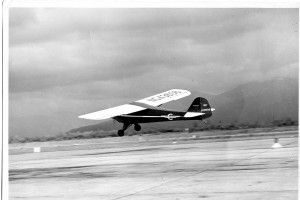1946 Taylorcraft BC-12D NC43606

Taylorcraft 19 |
||
| Crew: | One | |
|---|---|---|
| Capacity: | One passenger | |
| Length: | 22 ft 9 in | 6.9 m |
| Wingspan: | 36 ft | |
| Empty Weight: | 860 lb | 390 kg |
| Gross weight: | 1,500 lb | 680 kg |
| Powerplant: | Continental O-200A | |
| 65 hp | 48 kW |
|
| Performance | ||
| Cruise Speed: | 110 mph (96 kn) | 177 km/h |
| Maximum Speed: | 120 mph (104 kn) | 193 km/h |
| Stall Speed: | 38 mph (33 kn) | 61 km/h |
| Range: | 300 mi (261 nmi) | 483 km |
| Service ceiling: | 17,000 ft | 5,200 m |
| Rate of climb: | 700 ft/min | 3.6 m/s |
1946 NC43606 Taylorcraft BD12
Taylorcraft NC43606 was built in 1946. It was purchased by Jack Carr, along with two additional Taylorcraft planes of the same model, that year. Carr was the Alaska Factory Representative for Taylorcraft and brought dozens of Taylorcrafts to Alaska in the years following WWII. NC43606 was flown out of the factory to Seattle, then disassembled and loaded on to a Pacific Northwest Airways DC-3.
Typically, planes were sent to Alaska on a ship or they were flown up to their destination. However, during this time the “Teamsters”, a union that shipping employees were involved in, were on strike at the time. Shipping had not occured on the west coast for some months and did not resume until months later. The cost for shipping by air was seventy cents per pound, so the need for these planes at the time was quite dire.
Once in Alaska, NC43606 was used immediately for training pilots and charter work out of Merill Field. Not only was this plane a workhorse for the Jack Carr Flying Service, it was a spectacle for crowds.
In August 1946, Merill Field held an air show featuring military demonstrations, balloon busting, spot landings, and racing with motorcycles. Carr decided to attempt a demonstration featuring NC43606 and an identical Taylorcraft. Al Lindemuth piloted the NC43606, which pulled up and towed the other Taylorcraft, piloted by Carr, around the airfield a couple of times. Then, Carr pulled a pin that would release a tow rope connected to the other plane. Once released Carr glided back down to the airfield, landing safely.
In 1949, NC43606 was sold into the private sector and is believed to have stayed in Alaska since being sold. In 2007, the Alaska Aviation Museum received the aircraft. Thanks to the museum’s staff and volunteers, NC43606 was restored to original factory colors and the Jack Carr Service logo placed on the side.